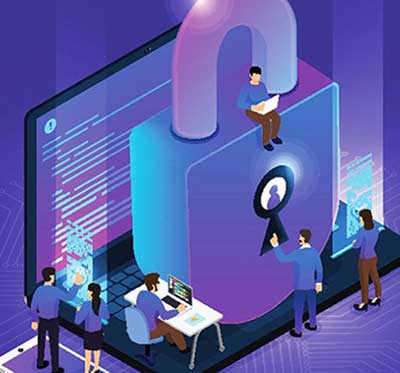Relevance: GS-3: Basics of Cyber Security.
Key Phrases: CERT-In, NCIIPC, NCCC, I4C, Singularity XDR, Stone Panda, NCSC;
Context
- The CERT-In (Indian Computer Emergency Response Team), recently came up with a new directive where companies will have to report the cybercrime within 6 hours of its detection.
- As more Indians increase their presence in cyberspace, Cybersecurity becomes essential for protecting the national interest.
Key Highlights
What is Cybersecurity?
- It involves protecting computational systems (Computers, mobiles, servers, etc) in cyberspace, including the Critical Information Infrastructure (banking infra, Health infra, Power infra), from cyber-attacks by adversaries.
- 4 main threats to Cyberspace
- Cyber Crime: any criminal activity which involves the usage of computational systems.
- Cyber Espionage: Spying through computational systems.
- Cyber Warfare: Misuse of computational systems by one country to disrupt the computers or information networks of other countries.
- Cyber Terrorism: Misinformation Campaign and other activities being carried out by terrorists to advance their political and ideological gains.
Why is Cybersecurity needed?
- Cybersecurity is essential for national security
- Global Cyber Security Index 2021 has placed India in 10th Position.
- India will have to put extra attention to cybersecurity for securing its dream of a $ 5Tn economy by 2024.
- Increased cyber presence has increased vulnerability.
- 800 Mn Indians have a digital presence with 400 Mn additional to join the digital space by 2025.
- 231% increase in internet connection in the last 8 years as India’s data cost per GB has come down by 96%.
- The number of cybercrimes per lakh population has increased by 270%.
- 136 cybercrime cases were reported every day in 2020.
- Protecting Companies
- Companies’ competitive advantage is often the target of cyber attacks.
- Protecting Individuals
- Increased cases of ransomware have been reported.
- Safeguarding Government assets
- Cyberattacks by non-state actors like ‘Stone Panda’ on critical information infrastructure have increased.
- As per Cyfirma, a cybersecurity firm, Countries have started engaging in cyberwarfare. Eg Russian and North Korean hackers have attacked facilities in the US.
Steps Taken
- The CERT-In mandated cybersecurity reporting to the authorities within six hours for all incidents.
- Legislative measures
- IT Act 2000 (Information Technology) for convicting cyber criminals.
- Institutional Measures
- CERT-IN (Computer Emergency Response Team) under MEITy for swift action against ongoing cyber attacks.
- I4C (Indian Command Control Center for Cybercrimes) for coordination in tackling cybercrimes. It is under MHA.
- NCCC (National Cyber Coordination Centre) for threat analysis.
- NCIIPC (National Critical Information Infrastructure Protection centre) for critical infrastructure protection.
- National Cyber Security Coordinator - to coordinate between different agencies carrying cybersecurity initiatives.
- Policy Measures
- National Cyber Security Policy 2013, which led to the establishment of NCIIPC, I4C, and NCCC.
- Initiative
- International Initiatives
- Budapest convention to build consensus on joint action against cybercrimes by tweaking national laws and bringing in synergy to investigate and analyse cybercrimes.
- Internet Governance Forum - for bringing all stakeholders together for bettering internet governance.
- National Initiative
- Cyber Surakshit Bharat Initiative.
- Cyber Swachhta Kendra is operated by CERT-In.
- International Initiatives
- Technological measures
- Singularity XDR (extended detection and response) for enhanced protection of the assets of the companies.
Challenges/ Concerns
- The Recent directive by CERT-In
- An increase in the cost of compliance of companies to provide the information within the timeframe.
- Lack of tools to comply with directives.
- Privacy concerns as the company will have to share IT logs for 6 months.
- Institutional Challenges
- A plethora of agencies and institutions results in a fragmented approach to cyber security.
- NCSC hasn’t been provided with liaison officers from the states.
- NCIIPC and CERT-In lack skilled manpower to carry out their designated tasks with efficiency.
- Human Resource Challenges
- ○ Cybersecurity hasn’t been included in the formalised curriculum.
- ○ Lack of sufficient informational awareness to the individuals regarding phishing, spoofing etc.
- ○ Companies lack designated personnel to shield themselves against attacks.
- Concerns in Industry
- Companies often don’t put 2-factor authorisation (2FA) before using GMAIL for official communication.
Way Forward
- Usage of singularity XDR
- It extends beyond the endpoint and provides end-to-end enterprise visibility and protection.
- Powered by Machine Learning it can be manned by smaller support staff.
- Seamless integration among agencies for foolproof protection against cyber attacks.
- A Centre of Excellence must be created for augmentation of HR in the field of Cybersecurity.
- Cybersecurity Help Desk at regional levels must be created as the first level of guidance and support.
- National Cyber Security Policy 2020 must be brought for upgrading our fight against cyberattacks.
Conclusion
- The recent directive will lead to an enhanced cyber security posture across stakeholders. Improving cybersecurity and reducing threats is always the right response.
Source: The Hindu BL
Mains Question:
Q. Explain the Cybersecurity architecture in India? What are the challenges in recent times? What more can be done?








